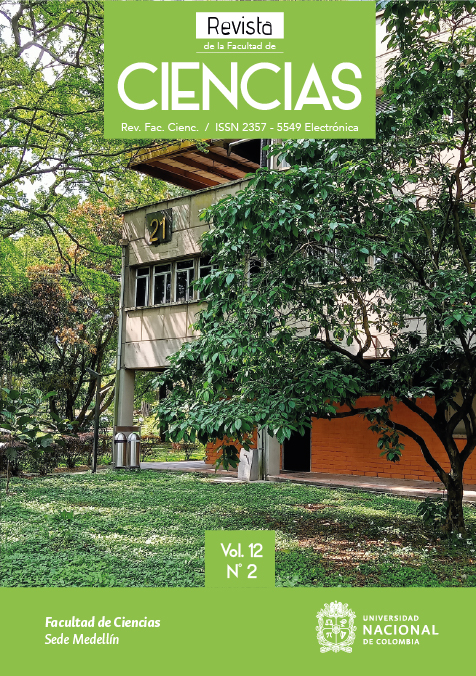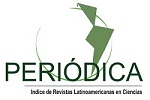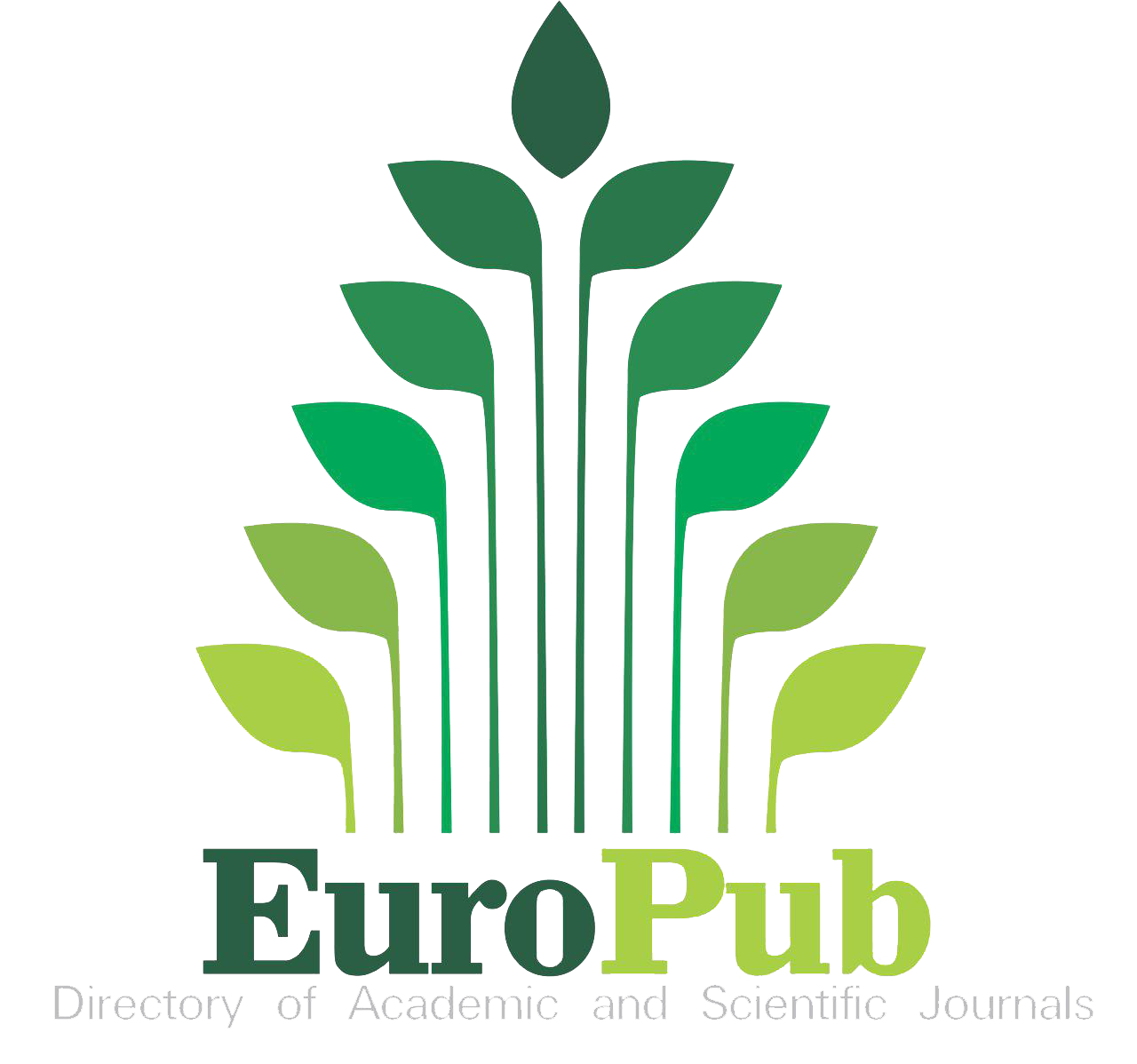ANÁLISIS DEL DESEMPEÑO MECÁNICO DE MINERALES DE USO INDUSTRIAL EN ZONAS COMUNITARIAS MINERAS DEL MUNICIPIO DE VALLEDUPAR
ANALYSIS OF THE MECHANICAL PERFORMANCE OF ORE FOR INDUSTRIAL USE IN COMMUNITY MINING AREAS IN THE MUNICIPALITY OF VALLEDUPAR
DOI:
https://doi.org/10.15446/rev.fac.cienc.v12n2.104545Keywords:
caracterización, Fisicoquímica, resistencia, ladrillos, temperatura (es)characterization, bricks, mechanical strength, physicochemical, temperature (en)
Downloads
El objetivo de este trabajo es mostrar el análisis del desempeño mecánico de los minerales de uso industrial en zonas comunitarias mineras del municipio de Valledupar, mediante la caracterización fisicoquímica, térmica y mecánica de los materiales presentes en los frentes de explotación activos de la zona en estudio. Se propone realizar caracterizaciones fisicoquímicas, térmicas y mecánicas para comparar las variables de procesos asociadas con la distribución de tamaño de partículas, límites de consistencia y plasticidad, composición química elemental, composición mineralógica y la variación de las temperaturas de cocción de los elementos de prueba, con respecto a las resistencias mecánicas de los materiales arcillosos elaborados a partir de las condiciones operativas de campo y las condiciones operativas controladas en laboratorio. Se concluyo que a medida que se aumenta la temperatura de cocción y se ajustan algunas variables de procesos de los materiales en estudio, se genera un aumento significativo en las resistencias mecánicas y una disminución de los porcentajes de humedad de los productos finales elaborados.
The objective of this work is to show the analysis of the mechanical performance of industrial minerals in community mining areas of the municipality of Valledupar, through the physicochemical, thermal and mechanical characterization of the materials present in the active mining fronts of the area under study. Physicochemical, thermal and mechanical characterizations were carried out to compare the process variables associated with particle size distribution, consistency and plasticity limits, elemental chemical composition, mineralogical composition and the variation of firing temperatures of the test elements, with respect to the mechanical strength of the clay materials produced from the field operating conditions and the laboratory controlled operating conditions. It was concluded that as the firing temperature is increased and some process variables of the materials under study are adjusted, a significant increase in the mechanical strength and a decrease in the humidity percentages of the final products produced are generated.
References
Céspedes P., N. E., Fonseca G., U., Valencia R., J. S., & Carda C., J. B. (2014). Valoración de Minerales Arcillosos del departamento de Boyacá (Colombia) para la Producción de Materiales Cerámicos Gresificados. Qualicer, 1–11. www.qualicer.org
Cotes de Álvarez, M. C. (2017). Caracterización de las arcillas utilizadas en alfarería en tres corregimientos del municipio de Valledupar – César, Colombia. Revista de Investigación en el Campo del Arte, 13(23), 198–209. https://doi.org/10.14483/21450706.12999 DOI: https://doi.org/10.14483/21450706.12999
Darío, J., Malagón, P., & Córdoba, E. (2011). Caracterización de arcillas y preparación de pastas cerámicas para la fabricación de tejas y ladrillos en la región de Barichara, Santander. Dyna, 78(167), 50–58. http://bdigital.unal.edu.co/27863/1/25762-90324-1-PB.pdf
Enrique, R., Aguilar, G., & Noe, W. (2017). Caracterización de las arcillas del norte del Cauca, Colombia enclave para la optimización del proceso productivo de la industria ladrillera. Journal de Ciencia e Ingeniería, 9(1), 34-41. https://repository.unilibre.edu.co/bitstream/handle/10901/15538/PROYECTO DE GRADO.pdf?sequence=1&isAllowed=y
Estrada, D. & Espinosa de los monteros, J. (1982). El secado en productos cerámicos. Bol. Soc. Esp. Ceram. Vidr. 21 (6), 327--337. http://boletines.secv.es/upload/198221327.pdf
Fernandez, J. (1962). Plasticidad de las arcillas. Boletín de la Sociedad Española de Cerámica y Vidrio, 1(7), 449-472. https://dialnet.unirioja.es/servlet/articulo?codigo=7500781
Ferrer, L. (1964). Resistencia de los materiales cerámicos a los cambios bruscos de temperatura. Boletín de la Sociedad Española de Cerámica y Vidrio, 3(6), 603-610. http://boletines.secv.es/upload/196403603.pdf
García-León, R. A., Flórez Solano, E., & Acevedo Peñaloza, C. (2018). Caracterización térmica de mezclas de arcillas utilizadas en la fabricación de productos de mampostería para la construcción. Revista Colombiana de tecnologias de Avanzada (RCTA), 1(31), 22–30. https://doi.org/10.24054/16927257.v31.n31.2018.2760 DOI: https://doi.org/10.24054/16927257.v31.n31.2018.2760
Garcia Verduch, A. (1985). Origen y composicion de las arcillas cerámicas. Boletín de La Sociedad Española de Cerámica y Vidrio, 24 (6), 395-404.
Gippini, E. (1966). Transformaciones en la cocción. Materiales de Construcción, 16(124), 17–30. https://doi.org/10.3989/mc.1966.v16.i124.1696 DOI: https://doi.org/10.3989/mc.1966.v16.i124.1696
Henao Arrieta, A. P., García Palacio, D. F., Rodríguez, J. E., Hoyos Machado, Á. M., López, M. E., & Gómez Álvarez, C. (2016). Caracterización térmica, química y mineralógica de un tipo de arcilla roja propia de la región andina Colombiana, empleada para la producción de ladrillos para construcción. Revista Colombiana De Materiales, 9(9), 59–63. https://doi.org/10.17533/udea.rcm.326494
ICONTEC. (2018a). NTC 4205. Ingeniería civil y arquitectura. Unidades de mampostería de arcilla cocida. Ladrillos y bloques cerámicos. Norma Técnica Colombiana, http://www.cytarcillasyprefabricados.com/wp-content/uploads/2017/02/NTC-4205-Unidades-de-mamposteria-de-arcilla-ladrillos-y-bloques-ceramicos.pdf
ICONTEC. (2018b). Norma Técnica Colombiana 4017. https://qdoc.tips/norma-tecnica-colombiana-4017-pdf-free.html
Isel Cáceres, V., Sánchez-Molina, J., & Chaparro-García, A. L. (2017). Evaluación de arcillas caoliniticas-illiticas provenientes de la formación guayabo del Área Metropolitana de Cúcuta, Norte de Santander, Colombia. Revista ION, 30(1), 117–127. https://doi.org/10.18273/revion.v30n1-2017009 DOI: https://doi.org/10.18273/revion.v30n1-2017009
Manco-Jaraba, D. C., Martínez-Contreras, C. A., Gómez-Jiménez, J. E., Girales-Puerta, D. I., & Molina-Arenas, S. I. (2020). Caracterización fisicoquímica de las arcillas utilizadas en la preparación de pastas cerámicas para la producción de los lotes de ladrillo tipo h-10 en la empresa Ladrillera Valledupar s.a.s. (Colombia). Aibi Revista de Investigación, Administración e Ingeniería, 8(3), 54–59. https://doi.org/10.15649/2346030X.850 DOI: https://doi.org/10.15649/2346030X.850
Prieto R., G., Guatame, C. L., & Cárdenas, S. C. (comps). (2019). Recursos minerales de Colombia Vol 1. In Servicio Geológico Colombiano. https://www2.sgc.gov.co/Publicaciones/Cientificas/NoSeriadas/Documents/recursos-minerales-de-colombia-vol-1.pdf
Sembenelli, P. (1966). Los límites de Atterberg y su significado en la industria cerámica y ladrillera. Materiales de Construcción, 16(124), 5–14. https://doi.org/10.3989/mc.1966.v16.i124.1695 DOI: https://doi.org/10.3989/mc.1966.v16.i124.1695
Thorez, J. (1976). Practical identification of clay minerals : a handbook for teachers and students in clay mineralogy. Universite de Liege.
How to Cite
APA
ACM
ACS
ABNT
Chicago
Harvard
IEEE
MLA
Turabian
Vancouver
Download Citation
CrossRef Cited-by
1. Ali Kadhum Bidan, Zainab Shakir Abdullah Al-Ali. (2024). Evaluation of cytotoxic potential of silver nanoparticles biosynthesized using essential oils of Jasminum sambac against breast cancer and bacterial cells. 3 Biotech, 14(10) https://doi.org/10.1007/s13205-024-04058-8.
Dimensions
PlumX
Article abstract page views
Downloads
License
Copyright (c) 2023 Revista de la Facultad de Ciencias

This work is licensed under a Creative Commons Attribution-NonCommercial-NoDerivatives 4.0 International License.
The authors or copyright holders of each paper confer to the Journal of the Faculty of Sciences of Universidad Nacional de Colombia a non-exclusive, limited and free authorization on the paper that, once evaluated and approved, is sent for its subsequent publication in accordance with the following characteristics:
- The corrected version is sent according to the suggestions of the evaluators and it is clarified that the paper mentioned is an unpublished document on which the rights are authorized and full responsibility is assumed for the content of the work before both the Journal of the Faculty of Sciences, Universidad Nacional de Colombia and third parties.
- The authorization granted to the Journal will be in force from the date it is included in the respective volume and number of the Journal of the Faculty of Sciences in the Open Journal Systems and on the Journal’s home page (https://revistas.unal.edu.co/index.php/rfc/index), as well as in the different databases and data indexes in which the publication is indexed.
- The authors authorize the Journal of the Faculty of Sciences of Universidad Nacional de Colombia to publish the document in the format in which it is required (printed, digital, electronic or any other known or to be known) and authorize the Journal of the Faculty of Sciences to include the work in the indexes and search engines deemed necessary to promote its diffusion.
- The authors accept that the authorization is given free of charge, and therefore they waive any right to receive any emolument for the publication, distribution, public communication, and any other use made under the terms of this authorization.
- All the contents of the Journal of the Faculty of Sciences are published under the Creative Commons Attribution – Non-commercial – Without Derivative 4.0.License
MODEL LETTER OF PRESENTATION and TRANSFER OF COPYRIGHTS
Personal data processing policy
The names and email addresses entered in this Journal will be used exclusively for the purposes set out in it and will not be provided to third parties or used for other purposes.





















